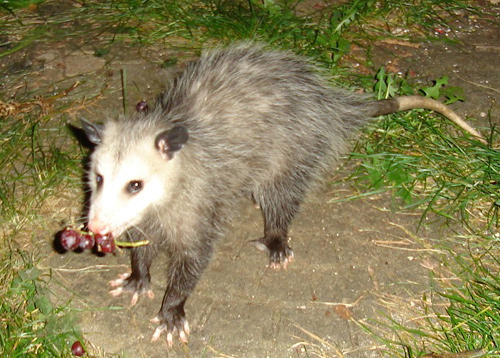Opossums, sometimes less correctly referred to as "possums" are very common in Connecticut. They are the only marsupial in the US. Opossums have long grizzled grey-white fur. Their heads and throats are white and their faces long and pointy. They have naked ears and naked tails that may be pinkish or greyish. Their tail looks like a long rat's tail and is 10 to 21 inches long. Their tail is prehensile and can grasp branches or objects, but opossums cannot hang from their tails. The poor opossum has never been considered a beauty and is often rather scruffy-looking. They weigh 4 to 14 lbs.
Oppossums range through the eastern 2/3 of the continental US, along some coastal areas of California and into Mexico. They have only moved into the northern regions such as Connecticut and New England in the last 100 years or so, but are very common here now. The adaptable opossum lives in open wooded areas, brushy areas, farmlands, wetlands and residential areas. They are primarily nocturnal and are active year-round.
Opposums are omnivorous. They scavenge carrion frequently and will also eat insects, frogs, small mammals, fruits and corn. They will eat from human garbage.
Opossum in Connecticut mate in early March. The gestation period is a very short 12 to 13 days. The babies are born in practically an embryonic stage. The first challenge in an opossum's life is the arduous journey from the mother opossum's birth canal underneath her tail to her furry abdominal pouch. The presence of such a pouch is characteristic of marsupials. The babies are about the size of a navy bean and any that fail to reach the pouch or attach to one of the nipples inside will die. The babies complete their development attached to the nipple inside the pouch for another 2 months. Once they leave the pouch the young opossums stay with their mother for another 4 to 6 weeks and will often ride clinging to their mother's back. A mother usually bears 1 to 9 young, and cares for them alone. In more southern regions opossums may bear two litters a year.
Opossums are solitary except when a female is raising her young. They use dens for bearing young and for shelter, especially in winter. Dens can be located in tree cavities, rock or brush piles, under buildings or in old burrows. Opossums are not ideally suited for northern winters, and although they stay active during the winter they may den up during extended cold. Opossums in the north often get frostbite on their furless ears or tails.
Opossum are not aggressive and would rather retreat than fight. They will hiss and screech and open their mouths to display their teeth when threatened, especially in encounters between males. The best known defense mechanism of the opossum is its habit of "playing dead". A frightened opossum keels over, limp, with tongue protruding and eyes shut, looking quite lifeless. Rather than being a deliberate act, this has recently been determined to be an involuntary, paralytic response to shock. The poor thing "faints" in a manner of speaking. If left in peace it will revive and go on its way.
Neat Fact
"Opossum" refers only to the Virginia Opossum, the only marsupial living in the US. The name comes from the algonquian Indian word aposoum which means "white beast". "Possums" are marsupials found in the eastern hemisphere and native to places like Austrailia and New Guinea. However the word "possums" is used in the common vernacular to refer to Virginia opossums as well.
Male opossum have a forked penis. This led to the erroneous belief that male opossums mated with a female through her nose.
Opossums have been observed using their tails to carry grasses and leaves to line a den.
